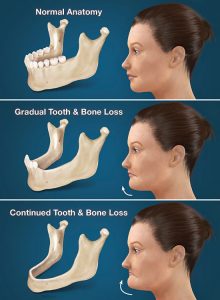Dental Implants and Bone Loss: What You Need to Know
If you’re missing one or more teeth, dental implants are an excellent way to restore your smile. They look and feel like natural teeth and can last a lifetime with diligent care. However, dental implants rely on healthy jawbone to support them.
If you’ve experienced bone loss, it can make getting implants more difficult. Luckily, there are ways to prevent further bone loss and even build new bone so you can still enjoy the benefits of dental implants.
Columbus, OH, implant dentist Dr. Sam Latif explains the connection between bone loss and dental implant candidacy on our blog.
What Causes Bone Loss?

Other factors that can contribute to bone loss include:
- Gum disease: Infection and inflammation damage the bone and tissues
- Ill-fitting dentures: Pressure and rubbing from poor-fitting dentures wear away the bone
- Injury or trauma: Damage to the jaw can result in bone loss
- Health conditions: Diseases like diabetes and osteoporosis affect bone density
Why Is Bone Loss a Problem for Implants?
Dental implants are like artificial tooth roots. They need sufficient bone quantity and density to anchor them in place. If too much bone has been lost, there may not be enough to support the implant. The implant could fail to integrate with the bone or even fall out.
Signs of Bone Loss
Bone loss often occurs gradually, so you may not notice symptoms right away. However, some signs to watch for include:
- Loose or ill-fitting dentures
- Gum recession, making teeth look longer
- Bite changes or teeth shifting position
- Pain or swelling in the gums or jaw
Preventing Bone Loss
The good news is bone loss can be prevented or minimized. Here are some key ways to keep your jawbone strong and healthy:
Maintain Good Oral Hygiene
Brushing twice a day, flossing daily, and using an antibacterial mouthwash help prevent gum disease and tooth decay that can lead to bone loss. It’s also important to quit smoking, as this habit increases the risk of implant failure.
Get Regular Dental Check-Ups
Visit your dentist at least every six months for professional cleaning and exams. They can spot early signs of bone loss and gum disease so these issues can be treated promptly. Your dentist will also take X-rays periodically to monitor your bone levels.
Replace Missing Teeth Promptly
The longer you go with missing teeth, the more bone deterioration will occur. Getting dental implants or another tooth replacement option as soon as possible helps provide stimulation to the jawbone to keep it healthy.
Consider a Bone Graft
If you’ve already experienced significant bone loss, a bone graft may be recommended before getting implants. This procedure involves transplanting bone from another area of your body or using a special bone grafting material to encourage new bone growth in the jaw.
Treatment Options for Bone Loss
Bone Grafting
If you don’t have enough bone to support an implant, bone grafting is often the solution. There are different types of bone grafts:
- Autograft: Bone from another part of your own body, like the hip or chin
- Allograft: Bone from a human donor
- Xenograft: Bone from an animal source, usually cow
- Synthetic: A bone-like material
The graft material is placed in the area where the bone has been lost. Over several months, the graft stimulates your body to grow new bone cells to replace the graft.
Sinus Lift
A sinus lift, also called a sinus augmentation, is a specific type of bone graft used when there isn’t enough bone height in the upper jaw to place implants. The maxillary sinuses are located above the upper jawbone.
In a sinus lift, the sinus membrane is lifted upward and donor bone is inserted below to provide more bone height for implants. Several months of healing are needed for new bone to grow and fuse before implants can be placed.
Ridge Augmentation
The alveolar ridge is the bony ridge that surrounds the roots of the teeth. Ridge augmentation is a bone grafting procedure used to recreate the natural contour of the gums and jaw after tooth loss. The graft material is placed in the tooth socket to build up the ridge. Once healed, the newly formed bone provides a strong foundation for implants.
Guided Tissue Regeneration
This technique is sometimes used with bone grafting for patients with severe bone loss. A special membrane is placed over the bone graft site. This membrane acts as a barrier to prevent the gum tissue from growing into the area where new bone should form.
Protect Your Smile From Bone Loss With Dental Implants
While bone loss can complicate the dental implant process, that doesn’t mean you can’t enjoy the benefits of implants. Maintaining good oral hygiene and replacing missing teeth promptly are key to preventing bone deterioration.
For patients who have experienced bone loss, advanced grafting procedures make it possible to rebuild lost bone so implants can be placed successfully. If you’re considering dental implants, schedule a consultation with Dr. Sam Latif in Columbus, OH. Our experienced team will help you determine whether you’re a good candidate for dental implants.
